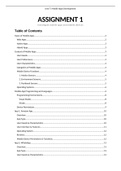Essay
Unit 7: Mobile Apps Development - Assignment 1 (P1, P2, M1, D1)
- Institution
- PEARSON (PEARSON)
This document is the first assignment of Unit 7: Mobile Apps Development in BTEC. It consists of 21 pages (6000+ words) that have met P1, P2, M1 and D1 which is required to get the highest possible grade (Distinction) in Assignment 1 (Learning Aim A). I have explained, analysed & evaluated effectiv...
[Show more]



